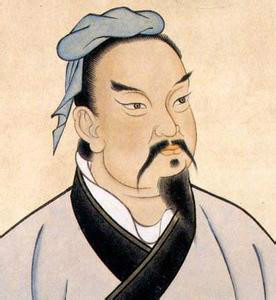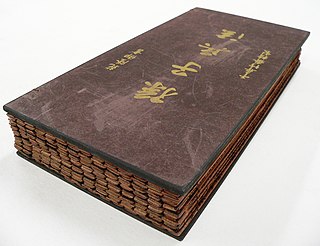Related Research Articles

Carl Philipp Gottfriedvon Clausewitz was a Prussian general and military theorist who stressed the "moral" and political aspects of waging war. His most notable work, Vom Kriege, though unfinished at his death, is considered a seminal treatise on military strategy and science.

Guerrilla warfare is a form of unconventional warfare in which small groups of irregular military, such as rebels, partisans, paramilitary personnel or armed civilians including recruited children, use ambushes, sabotage, terrorism, raids, petty warfare or hit-and-run tactics in a rebellion, in a violent conflict, in a war or in a civil war to fight against regular military, police or rival insurgent forces.

Vom Kriege is a book on war and military strategy by Prussian general Carl von Clausewitz (1780–1831), written mostly after the Napoleonic wars, between 1816 and 1830, and published posthumously by his wife Marie von Brühl in 1832. It is one of the most important treatises on political-military analysis and strategy ever written, and remains both controversial and influential on strategic thinking.

Sun Tzu was a Chinese military general, strategist, philosopher, and writer who lived during the Eastern Zhou period. Sun Tzu is traditionally credited as the author of The Art of War, an influential work of military strategy that has affected both Western and East Asian philosophy and military thought. Sun Tzu is revered in Chinese and East Asian culture as a legendary historical and military figure. His birth name was Sun Wu and he was known outside of his family by his courtesy name Changqing. The name Sun Tzu—by which he is more popularly known—is an honorific which means "Master Sun".

The Art of War is an ancient Chinese military treatise dating from the late Spring and Autumn Period. The work, which is attributed to the ancient Chinese military strategist Sun Tzu, is composed of 13 chapters. Each one is devoted to a different set of skills or art related to warfare and how it applies to military strategy and tactics. For almost 1,500 years, it was the lead text in an anthology that was formalized as the Seven Military Classics by Emperor Shenzong of Song in 1080. The Art of War remains the most influential strategy text in East Asian warfare, has influenced both East Asian and Western military theory and thinking, and has found a variety of applications in myriad competitive non-military endeavors across the modern world including espionage, culture, politics, business, and sports.

Võ Nguyên Giáp was a militarily self-taught general of the People's Army of Vietnam (PAVN), communist revolutionary and politician. Regarded as one of the greatest military strategists of the 20th century, Giáp commanded Vietnamese communist forces in various wars. He served as the military commander of the Việt Minh and later the PAVN from 1941 to 1972, as the minister of defence of the Democratic Republic of Vietnam and later Socialist Republic of Vietnam in 1946–1947 and from 1948 to 1980, and as deputy prime minister from 1955 to 1991. He was also a member of the Politburo of the Communist Party of Vietnam.
Military strategy is a set of ideas implemented by military organizations to pursue desired strategic goals. Derived from the Greek word strategos, the term strategy, when first used during the 18th century, was seen in its narrow sense as the "art of the general", or "the art of arrangement" of troops. and deals with the planning and conduct of campaigns, the movement and disposition of forces, and the deception of the enemy.
De re militari, also Epitoma rei militaris, is a treatise by the Late Latin writer Publius Flavius Vegetius Renatus about Roman warfare and military principles as a presentation of the methods and practices in use during the height of the Roman Empire and responsible for its power. The extant text dates to the 5th century.
Marketing warfare strategies represent a type of strategy, used in commerce and marketing, that tries to draw parallels between business and warfare and then applies the principles of military strategy to business situations, with competing firms considered as analogous to sides in a military conflict, and market share considered as analogous to territory in dispute. This view of marketing argues that in mature, low-growth markets, where real GDP growth is negative or low, commerce operates as a zero-sum game. One participant's gain is possible only at another participant's expense. Success depends on battling competitors for market share.
Attrition warfare is a military strategy consisting of belligerent attempts to win a war by wearing down the enemy to the point of collapse through continuous losses in personnel, materiel, and morale. The word attrition comes from the Latin root atterere, meaning "to rub against", similar to the "grinding down" of the opponent's forces in attrition warfare.

Sir Julian Stafford Corbett was a prominent British naval historian and geostrategist of the late 19th and early 20th centuries, whose works helped shape the Royal Navy's reforms of that era. One of his most famous works is Some Principles of Maritime Strategy, which remains a classic among students of naval warfare. Corbett was a good friend and ally of naval reformer Admiral John "Jacky" Fisher, the First Sea Lord. He was chosen to write the official history of British Naval operations during World War I.

Sun Bin was a Chinese general, military strategist, and writer who lived during the Warring States period of Chinese history. A supposed descendant of Sun Tzu, Sun was tutored in military strategy by the hermit Guiguzi. He was accused of treason while serving in the Wei state and was sentenced to face-tattooing and had his kneecaps removed, permanently crippling him. Sun escaped from Wei later and rose to prominence in the Qi state, by serving as a military strategist and commander. He led Qi to victory against the Wei state at the Battle of Guiling and Battle of Maling. Sun authored the military treatise Sun Bin's Art of War, which was rediscovered in a 1972 archaeological excavation after being lost for almost 2000 years.
Principles of war are rules and guidelines that represent truths in the practice of war and military operations.

André Beaufre was a French Army officer and military strategist who attained the rank of Général d'Armée before his retirement in 1961.
The following outline is provided as an overview of and topical guide to military science:
Military theory is the study of the theories which define, inform, guide and explain war and warfare. Military Theory analyses both normative behavioral phenomena and explanatory causal aspects to better understand war and how it is fought. It examines war and trends in warfare beyond simply describing events in military history. While military theories may employ the scientific method, theory differs from Military Science. Theory aims to explain the causes for military victory and produce guidance on how war should be waged and won, rather than developing universal, immutable laws which can bound the physical act of warfare or codifying empirical data, such as weapon effects, platform operating ranges, consumption rates and target information, to aid military planning.
The main strategy and tactics of guerrilla warfare tend to involve the use of a small attacking, mobile force against a large, unwieldy force. The guerrilla force is largely or entirely organized in small units that are dependent on the support of the local population. Tactically, the guerrilla army makes the repetitive attacks far from the opponent's center of gravity with a view to keeping its own casualties to a minimum and imposing a constant debilitating strain on the enemy. This may provoke the enemy into a brutal, excessively destructive response which will both anger their own supporters and increase support for the guerrillas, ultimately compelling the enemy to withdraw. One of the most famous examples of this was during the Irish War of Independence. Michael Collins, a leader of the Irish Republican Army, often used this tactic to take out squads of British soldiers, mainly in Munster, especially Cork.
The history of guerrilla warfare stretches back to ancient history. While guerrilla tactics can be viewed as a natural continuation of prehistoric warfare, the Chinese general and strategist Sun Tzu, in his The Art of War, was the earliest to propose the use of guerrilla warfare. This directly inspired the development of modern guerrilla warfare. Communist leaders like Mao Zedong and North Vietnamese Ho Chi Minh both implemented guerrilla warfare in the style of Sun Tzu, which served as a model for similar strategies elsewhere, such as the Cuban "foco" theory and the anti-Soviet Mujahadeen in Afghanistan. While the tactics of modern guerrilla warfare originate in the 20th century, irregular warfare, using elements later characteristic of modern guerrilla warfare, has existed throughout the battles of many ancient civilizations.
The following outline is provided as an overview of and topical guide to war:

A military treatise or treatise on war is any work that deals with the "art of war" in some basic aspect. Fundamentally military treatises are treatises on military strategy. Other works may also be included in the definition that, although they deal with other topics, include sensitive information about military matters. These may include, among others, description of specific battles, sieges, general campaigns, reports of military authorities, and commented works about ground or naval battles.
References
- ↑ "Victor Davis Hanson".
- ↑ "Võ Nguyên Giáp". id.oclc.org. Retrieved 2023-07-30.